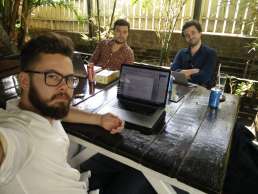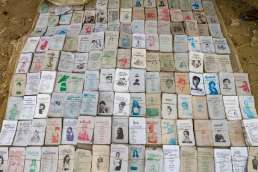Contact
Contact
Do you have a correction to make, an anecdote to share, or a topic you would like to see covered in a future edition of this book? Or do you simply want to get in touch with the authors? Then please drop us a line through the contact form below and we will be in touch with you.
All photographs on this website are available for licensing through manueloka.com.
For press inquiries and review copies please contact Gisela Graf Communications.
Bibilography
Bibliography
Afsheen, S. Under Five Flags: Life Like a Turbulent River Flows. Xlibris, 2001.
Andrus, James Russell. Burmese Economic Life. Stanford University Press, 1947.
Amrith, Sunil. Crossing the Bay of Bengal: The Furies of Nature and the Fortunes of Migrants. Harvard University Press, 2013.
Burmistrenko, Nikolai Alekseevich. Stroitel’stvo i Arkhitektura Birmy. Library of Congress, 1957.
Butwell, Richard. U Nu of Burma. Stanford University Press, 1969.
Fong, Kecia. “Imagining Yangon: Assembling Heritage, National Identity and Modern Futures.” Australia ICOMOS Historic Environment, 26.3 (2014): 26-39.
Frasch, Tilman. “Tracks in the City: Technology, Mobility, and Society in Colonial Rangoon and Singapore.” Modern Asian Studies, 46.1 (2012): 97-118.
Fredman Cernea, Ruth. Almost Englishmen: Baghdadi Jews in British Burma. Lexington Books, 2007.
Ghosh, Amitav. The Glass Palace. Random House, 2001.
Grant, Colesworthy. A Rough Trip to Rangoon in 1846. Orchid Press Publishing Limited, 1995.
Japan International Cooperation Agency, JICA. Yangon Urban Transport Master Plan: Major Findings on Yangon Urban Transport and Short-Term Actions. 2014.
Kamdar, Mira. Motiba’s Tattoos: A Granddaughter’s Journey Into Her Indian Family’s Past. Public Affairs, 2000.
Kraas, Frauke, Gaese, Hartmut, Mi Mi Kyi. Megacity Yangon. Transformation Processes and Modern Developments. LIT Verlag Münster, 2006.
Lamprakos, Michele. “The Idea of the Historic City.” Change Over Time, 4.1 (2014): 8-39.
Le Fleur, Sybil and Blanche, with Derek Flory. Torn Apart: How Two Sisters Found Each Other After Sixty-Five Years. Random House, 2011.
Lintner, Bertil. Outrage: Burma’s Struggle for Democracy. Weatherhill, 1995.
MacMillan, Allister. Seaports of the Far East. Collingridge, 1924.
Moore, Elizabeth Howard. “Unexpected Places at the Shwedagon.” A Companion to Asian Art and Architecture. Eds. Rebecca M. Brown and Deborah S. Hutton. Wiley-Blackwell, 2011.
Moore, Elizabeth Howard, Osiri, Navanath. “Urban Forms and Civic Space in Nineteenth- to Early Twentieth Century Bangkok and Rangoon.” Journal of Urban History, 40.1 (2014): 158-177.
Morris, Jan and Winchester, Simon. Stones of Empire: The Buildings of the Raj. Oxford University Press, 2005.
Myint-U, Thant. The River of Lost Footsteps: Histories of Burma. Farrar, Straus and Giroux, 2008.
Myint-U, Thant. Where China Meets India: Burma and the New Crossroads of Asia. Farar, Straus and Giroux, 2012.
Ozhegov, SS. Arkhitektura Birmy. Nauka Moscow, 1970.
Pearn, BR. A History of Rangoon. Rangoon Municipal Corporation, 1939.
Polk, Benjamin. Building for South Asia: An Architectural Autobiography. Abhinav Publications, 1994.
Popham, Peter. The Lady And The Peacock, The Life of Aung San Suu Kyi of Burma. Rider, 2012.
Rogers, Benedict. Burma: A Nation at the Crossroads. Random House, 2012.
Rooney, Sarah. 30 Heritage Buildings of Yangon: Inside the City that Captured Time. Serindia Publications, 2012.
Seekins, Donald. “The State and the City: 1988 and the Transformation of Rangoon.” Pacific Affairs 78.2 (2005): 257-275.
Seekins, Donald. Historical Dictionary of Myanmar (Burma). Scarecrow Press, 2006.
Seekins, Donald. State and Society in Modern Rangoon. Routledge, 2014.
Skidmore, Monica (ed.). Burma at the Turn of the Twenty-First Century. University of Hawaii Press, 2005.
Singer, Noel. Old Rangoon: City of the Shwedagon. Kiscadale Publications, 1995.
Spate, OHK and Trueblood, LW. “Rangoon: A Study in Urban Geography.” Geographical Review, 32.1 (1942): 56-73.
Squire, Raglan. Portrait of an Architect. Colin Smythe, 1984.
Stadtner, Donald M. Sacred Sites of Burma. River Books, 2010.
Thanegi, Ma and Broman, Barry Michael. Myanmar Architecture: Cities of Gold. Times Editions – Marshall Cavendish, 2005.
Tong, Chee-Kiong. Identity and Ethnic Relations in Southeast Asia: Racialising Chineseness. Springer, 2011.
Turnell, Sean. Fiery Dragons: Banks, Moneylenders and Microfinance in Burma. Nordic Institute of Asian Studies, 2009.
UN Habitat. Human Settlements Sector Review: Union of Myanmar. 1991.
Wright, Arnold. Twentieth Century Impressions of Burma: Its History, People, Commerce, Industries, and Resources. Lloyd’s Greater Britain Publishing Company, 1910.
Wright, Ashley. Opium and Empire in Southeast Asia: Regulating Consumption in British Burma. Palgrave Macmillan, 2013.
Yegar, Moshe. The Muslims of Burma: A Study of a Minority Group. Schriftenreihe des Südasien-Instituts der Universität Heidelberg, 1972.
Reviews and Media
Reviews and media
- “Lovingly documented” – The Guardian
- “This sumptuous, evocative book captures the energies of a city in the midst of rapid change. At the same time it is suffused with traces of Yangon’s complex, often troubled, past. I enjoyed the mix of architectural commentary, urban geography, and excellent photography that the authors bring to the book. It will be essential reading for anyone interested in Yangon and Myanmar; it works equally well as a guide for first-time visitors, and as an invitation to those who know the city to see it through fresh eyes.”
– Sunil Amrith, Professor of South Asian History at Harvard University
- “This is an excellent book that has something for everyone. Those new to Yangon will appreciate the depth and background of sites and their histories, as well as the fact that the book extends to neighborhoods not usually covered in guidebooks. As someone who has lived in the city for long stretches of time, I loved learning new things about places I regularly passed but never thought twice about. The writing on architectural styles was also very accessible for a non-specialist, just enough to make you feel that you’d learned something meaningful, but not too dense and mostly focused on contextualizing buildings within the city’s rich and diverse history.”
– Matthew Walton, Aung San Suu Kyi Senior Research Fellow at Oxford University
- “The book is refreshingly different – in its presentation of history, architecture, photography and current challenges. Its beauty lies in the fact that it is difficult to categorize it as any particular genre. It is poetic and lyrical, as well as gripping. It gives us an idea about the endless creative ways in which one can present a city and opens our hearts and minds into appreciating the latent stories embedded in colossal structures. The book inspires us in not only getting to know our cultural heritage but also involving ourselves in rejuvenating the same with sensibility and sensitivity.”
– Reshmi Banerjee, Oxford University’s Tea Circle blog (read the whole review here)
- German architectural magazine Bauwelt has reviewed the book here. A post with some translated passages is here.
- Coconuts Yangon has also reviewed the book and interviewed Elliott here. “The city that emerges in the Architectural Guide is both living and changing.”
- Elliott wrote an article about the book for Quartz on the eve of Myanmar’s historic elections in 2015.
You can buy the guide on Amazon (US, UK, Germany, France, Japan), or directly from the publisher.
The back cover text reads:
Architectural Guide Yangon presents around one hundred memorable buildings from Myanmar’s historical capital. Following decades of international isolation, the city’s vast heritage remains largely, surprisingly and spectacularly intact. Rangoon – as it was known under the British – was a melting pot of British India. Vivid traces of this legacy are everywhere, especially in the city’s Buddhist, Christian, Hindu, Jewish and Muslim houses of worship that often stand side by side, down town, in Yangon’s tightly-gridded streets. Since the country’s independence from the British in 1948, successive authoritarian regimes have also stamped the cityscape with their legacies. Today Yangon is a bustling and busy city in flux, at the frontier of Myanmar’s rapid opening to the wider world. Yangon’s urban fabric deserves a systematic guide that nourishes every visitor and resident’s shared fascination for the city and its history, offering countless anecdotes and notes on architectural detail.
Buy The Book
The paper copy of the Architectural Guide: Yangon is available through most book outlets internationally. We would love to see you asking your local bookshop to fill your order, first. However, you can also order the book yourself directly from our publisher or from online retailers such as Amazon.
Impressum
Impressum
Angaben gemäß § 5 TMG:

Disclaimer – rechtliche Hinweise
§ 1 Warnhinweis zu InhaltenDie kostenlosen und frei zugänglichen Inhalte dieser Webseite wurden mit größtmöglicher Sorgfalt erstellt. Der Anbieter dieser Webseite übernimmt jedoch keine Gewähr für die Richtigkeit und Aktualität der bereitgestellten kostenlosen und frei zugänglichen journalistischen Ratgeber und Nachrichten. Namentlich gekennzeichnete Beiträge geben die Meinung des jeweiligen Autors und nicht immer die Meinung des Anbieters wieder. Allein durch den Aufruf der kostenlosen und frei zugänglichen Inhalte kommt keinerlei Vertragsverhältnis zwischen dem Nutzer und dem Anbieter zustande, insoweit fehlt es am Rechtsbindungswillen des Anbieters.
§ 2 Externe Links
Diese Website enthält Verknüpfungen zu Websites Dritter ("externe Links"). Diese Websites unterliegen der Haftung der jeweiligen Betreiber. Der Anbieter hat bei der erstmaligen Verknüpfung der externen Links die fremden Inhalte daraufhin überprüft, ob etwaige Rechtsverstöße bestehen. Zu dem Zeitpunkt waren keine Rechtsverstöße ersichtlich. Der Anbieter hat keinerlei Einfluss auf die aktuelle und zukünftige Gestaltung und auf die Inhalte der verknüpften Seiten. Das Setzen von externen Links bedeutet nicht, dass sich der Anbieter die hinter dem Verweis oder Link liegenden Inhalte zu Eigen macht. Eine ständige Kontrolle der externen Links ist für den Anbieter ohne konkrete Hinweise auf Rechtsverstöße nicht zumutbar. Bei Kenntnis von Rechtsverstößen werden jedoch derartige externe Links unverzüglich gelöscht.
§ 3 Urheber- und Leistungsschutzrechte
Die auf dieser Website veröffentlichten Inhalte unterliegen dem deutschen Urheber- und Leistungsschutzrecht. Jede vom deutschen Urheber- und Leistungsschutzrecht nicht zugelassene Verwertung bedarf der vorherigen schriftlichen Zustimmung des Anbieters oder jeweiligen Rechteinhabers. Dies gilt insbesondere für Vervielfältigung, Bearbeitung, Übersetzung, Einspeicherung, Verarbeitung bzw. Wiedergabe von Inhalten in Datenbanken oder anderen elektronischen Medien und Systemen. Inhalte und Rechte Dritter sind dabei als solche gekennzeichnet. Die unerlaubte Vervielfältigung oder Weitergabe einzelner Inhalte oder kompletter Seiten ist nicht gestattet und strafbar. Lediglich die Herstellung von Kopien und Downloads für den persönlichen, privaten und nicht kommerziellen Gebrauch ist erlaubt.
Die Darstellung dieser Website in fremden Frames ist nur mit schriftlicher Erlaubnis zulässig.
§ 4 Besondere Nutzungsbedingungen
Soweit besondere Bedingungen für einzelne Nutzungen dieser Website von den vorgenannten Paragraphen abweichen, wird an entsprechender Stelle ausdrücklich darauf hingewiesen. In diesem Falle gelten im jeweiligen Einzelfall die besonderen Nutzungsbedingungen.
Authors
Authors and Contributors
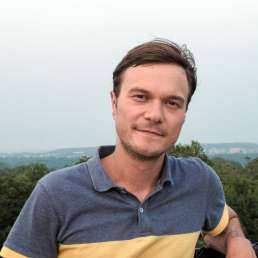
Ben Bansal
— 1981, Berlin
is an economist with degrees from the School of Oriental and African Studies (SOAS) in London and Cambridge University. Ben has worked in finance for most of his career, as an economist, fund manager and banker. Since going freelance a few years ago, several of his assignments have dealt with Myanmar’s economic transition, bringing him to Yangon and piquing his interest in the city. His academic research interests include the economic history of post-war Tokyo and contemporary urban development issues in South and Southeast Asia.
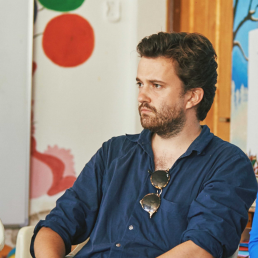
Elliott Fox
— 1987, Paris
is a media adviser in the humanitarian and human rights sectors. He studied politics and communications at SOAS, the London School of Economics and City University’s Graduate School of Journalism. He started working on Myanmar issues while interning at the United Nations in 2008. Since then he has traveled to Myanmar regularly: as a press officer for visiting former heads of state and Nobel Peace Prize laureates, as a tourist and, of course, to write this book.
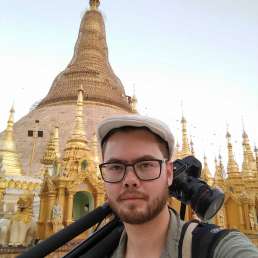
Manuel Oka
— 1983, Munich
is an architect and freelance photographer. Manuel graduated in architecture from Vienna Technical University and went on to study in Yoshiharu Tsukamoto’s graduate studio at the Tokyo Institute of Technology. He worked for architectural firms Fumihiko Maki and KMDW in Tokyo before moving to Munich where he is currently working. Manuel spent several months researching the book and shooting in Myanmar. His photos can be found at manueloka.com
Special Thanks
In memory of Bob Percival.
Above all, we would like to thank Franz Xaver Augustin and the Yangon Goethe-Institut for their enthusiasm and generous support. Kecia Fong provided patient mentorship and invaluable help with heritage related questions. Heinz Schütte generously read the entire manuscript and provided valuable feedback. Zaw Lin Myat supported the project from the start and helped wherever he could. In U Hpone Thant (Harry) we found a most helpful resource to answer many of our particular questions about Yangon’s post-independence history, and where it unfolded. In Yangon, many people helped us with their expertise, during interviews: U Tun Than, Daw Moe Moe Lwin, Dr. Kyaw Lat, U Sun Oo, Maki Morikawa, Masahiko Suzuki, Amelie Chai and Stephen Zawmoe Shwe deserve a special mention. Special gratitude must also go to U Kin Maun Lwin for taking the time to take us around Yangon University. U Soe Lin provided valuable insights into Burmese architecture in Washington, D.C. Patrick Robert encouraged this project from the beginning and unlocked usually off-limits buildings for the authors, connecting them with many other individuals along the way. We are indebted to Graham and Charmaine Lewis for kindly translating and paraphrasing a Burmese article about the Martyrs’ Memorial. Bob Percival has been a great supporter and friend of the authors, enlivening their time in Yangon with wisdom and good humour. Takashi Kamiyama’s logistical help was greatly appreciated. Sarah Rooney, Melissa Cate Christ, Petr Kozma, Susmit Banerjee, Laetitia Millois, Ilaria Benini, Ben White, Bram Steenhuisen, U Thurein Aung, Ben Wolford, Stewart Traill, Elizabeth Rhoads and Oliver von Braun-Dams provided valuable feedback or helped with individual research-related questions. Special thanks to Kasita Rochanakorn for copy-editing the manuscript. The usual caveats apply.

Copy-editing
Kasita Rochanakorn
Proofreading
Mariangela Palazzi-Williams
Final corrections
Clarice Knowles
Design
Manuel Oka
Maps
Katrin Soschinski
QR codes
Christoph Gößmann
Image Processing
Tiger Printing (Hong Kong) Co., Ltd.
Printing
Spindulio Spaustuvė, Kaunas
